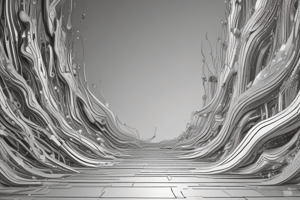Podcast
Questions and Answers
EASY What happens to the steam in the condenser section of a deaerator?
EASY What happens to the steam in the condenser section of a deaerator?
- It is used to control the pressure
- It is used to heat the water
- It condenses and falls back into the deaerator (correct)
- It is vented to the atmosphere
What is the purpose of the steam pressure controller?
What is the purpose of the steam pressure controller?
- To regulate the steam flow (correct)
- To vent the gases to the atmosphere
- To heat the water
- To control the level of water in the deaerator
What is the function of the overflow valve?
What is the function of the overflow valve?
- To regulate the water level (correct)
- To control the pressure in the deaerator
- To heat the water
- To vent the gases to the atmosphere
What is the purpose of the level alarm low?
What is the purpose of the level alarm low?
How does a tray-type deaerator work?
How does a tray-type deaerator work?
What is the purpose of the internal vent condenser?
What is the purpose of the internal vent condenser?
What is the function of the steam flow gauge?
What is the function of the steam flow gauge?
What is the purpose of the safety valve?
What is the purpose of the safety valve?
How does a bubbling tray deaerator work?
How does a bubbling tray deaerator work?
What is the function of the level control valve?
What is the function of the level control valve?
What happens to dissolved gases in water as the temperature rises?
What happens to dissolved gases in water as the temperature rises?
Why are deaerators used in boiler feedwater systems?
Why are deaerators used in boiler feedwater systems?
What is the purpose of scrubbing the water with steam in a deaerator?
What is the purpose of scrubbing the water with steam in a deaerator?
What is the effect of increasing temperature on the solubility of dissolved gases in water?
What is the effect of increasing temperature on the solubility of dissolved gases in water?
What is the purpose of the trays in a tray-type deaerator?
What is the purpose of the trays in a tray-type deaerator?
What is the difference between a tray-type and spray-type deaerator?
What is the difference between a tray-type and spray-type deaerator?
What is the purpose of the spray nozzles in a spray-type deaerator?
What is the purpose of the spray nozzles in a spray-type deaerator?
What is the result of not removing dissolved gases from boiler feedwater?
What is the result of not removing dissolved gases from boiler feedwater?
MEDIUM What is the primary benefit of increasing the surface area of the water in a deaerator?
MEDIUM What is the primary benefit of increasing the surface area of the water in a deaerator?
What is the role of turbulence in a deaerator?
What is the role of turbulence in a deaerator?
What happens to the oxygen and carbon dioxide in the deaerator?
What happens to the oxygen and carbon dioxide in the deaerator?
What is the effect of residence time on a deaerator's efficiency?
What is the effect of residence time on a deaerator's efficiency?
What is the purpose of the condenser section in a deaerator?
What is the purpose of the condenser section in a deaerator?
What is the function of the Level Control Valve?
What is the function of the Level Control Valve?
What is the purpose of heating the water in a deaerator?
What is the purpose of heating the water in a deaerator?
Which of the following is a key difference between a tray-type and spray-type deaerator?
Which of the following is a key difference between a tray-type and spray-type deaerator?
What is the purpose of the steam in a deaerator?
What is the purpose of the steam in a deaerator?
What is the difference between an internal vent condenser and an external vent condenser?
What is the difference between an internal vent condenser and an external vent condenser?
What is the result of removing dissolved gases from boiler feedwater?
What is the result of removing dissolved gases from boiler feedwater?
Why is it important to vent the released gases from the deaerator?
Why is it important to vent the released gases from the deaerator?
What is the purpose of the combination deaerator?
What is the purpose of the combination deaerator?
What is the purpose of combining the steam flow with the water in a deaerator?
What is the purpose of combining the steam flow with the water in a deaerator?
What is the effect of increasing the water temperature in a deaerator?
What is the effect of increasing the water temperature in a deaerator?
What is the purpose of the perforated panels in a bubbling tray deaerator?
What is the purpose of the perforated panels in a bubbling tray deaerator?
What is the purpose of the safety valve in a deaerator?
What is the purpose of the safety valve in a deaerator?
What is the result of deaerating the water in a deaerator?
What is the result of deaerating the water in a deaerator?
What is the primary factor that affects the solubility of dissolved gases in water?
What is the primary factor that affects the solubility of dissolved gases in water?
Which of the following operating parameters is not directly affected by the design of the deaerator?
Which of the following operating parameters is not directly affected by the design of the deaerator?
What is the primary benefit of using a combination deaerator?
What is the primary benefit of using a combination deaerator?
Which of the following is a disadvantage of the spray-type deaerator compared to the tray-type deaerator?
Which of the following is a disadvantage of the spray-type deaerator compared to the tray-type deaerator?
What is the primary purpose of the scrubber in a deaerator?
What is the primary purpose of the scrubber in a deaerator?
What is the effect of increasing the residence time in a deaerator?
What is the effect of increasing the residence time in a deaerator?
Which of the following is a characteristic of the tray-type deaerator?
Which of the following is a characteristic of the tray-type deaerator?
HARD What is the primary reason for venting the released gases from the deaerator?
HARD What is the primary reason for venting the released gases from the deaerator?
What is the primary function of the steam in the deaerator during the heating process?
What is the primary function of the steam in the deaerator during the heating process?
What is the purpose of the trays in a combination deaerator?
What is the purpose of the trays in a combination deaerator?
What is the effect of increasing the residence time in a deaerator?
What is the effect of increasing the residence time in a deaerator?
What is the purpose of the internal vent condenser in a combination deaerator?
What is the purpose of the internal vent condenser in a combination deaerator?
What is the role of the overflow valve in a deaerator?
What is the role of the overflow valve in a deaerator?
What is the primary benefit of using a bubbling tray deaerator?
What is the primary benefit of using a bubbling tray deaerator?
What is the purpose of the thermometer in a deaerator?
What is the purpose of the thermometer in a deaerator?
What is the effect of increasing the water temperature in a deaerator?
What is the effect of increasing the water temperature in a deaerator?
What is the purpose of the safety valve in a deaerator?
What is the purpose of the safety valve in a deaerator?
What is the primary difference between an internal vent condenser and an external vent condenser?
What is the primary difference between an internal vent condenser and an external vent condenser?
Flashcards are hidden until you start studying
Study Notes
Boiler Feedwater Systems and Deaerators
- Dissolved gases, such as oxygen and carbon dioxide, have lower solubility in water as the water temperature rises.
- Deaerators are used to remove dissolved gases from boiler feedwater to prevent corrosion in boilers.
Deaerator Operating Parameters
- Temperature: an increase in temperature reduces the solubility of dissolved gases.
- Turbulence: steam flow ensures efficient mixing in support of gas scrubbing.
- Surface Area: the use of trays increases the surface area of the water, which improves the degassing efficiency.
- Time: a deaerator's efficiency is a function of the residence time.
Deaerator Configurations
- Tray Type: inlet water is directed into a steam chamber, where it heats up and then cascades down several trays to increase the surface area of the water.
- Spray Type: inlet water is broken up into small particles with spray nozzles to promote water-steam contact.
Deaerator Components and Control Mechanisms
- Steam Supply
- Steam Flow Gauge
- Level Control Valve
- Relief Valve
- Level Alarm Low and Low-Low
- Pressure Gauge
- Air Vent
- Condensate Safety Valve
- Thermometer
- Vent
Deaerator Process
- Inlet water is heated and scrubbed with steam to release dissolved gases.
- Released gases and steam are vented from the deaerator.
- Degassed water is stored in the deaerator and withdrawn continuously as needed by the boiler feedwater pump.
Tray-Type Deaerator
- Water flow is broken up by trickling down over a series of trays.
- Entering steam scrubs the water in the lower trays and heats the water in the upper tray section.
- Released gases and remaining steam pass to the internal vent condenser, where most of the steam is condensed and the gases are vented to atmosphere.
Combination Deaerator
- Water is first sprayed into the upper heating section of the deaerator.
- Then, it trickles over a series of steam-swept trays.
- Released gases and remaining steam pass through the incoming water spray on their way to the vent opening, causing most of the steam to condense.
Boiler Feedwater Systems and Deaerators
- Dissolved gases, such as oxygen and carbon dioxide, have lower solubility in water as the water temperature rises.
- Deaerators are used to remove dissolved gases from boiler feedwater to prevent corrosion in boilers.
Deaerator Operating Parameters
- Temperature: an increase in temperature reduces the solubility of dissolved gases.
- Turbulence: steam flow ensures efficient mixing in support of gas scrubbing.
- Surface Area: the use of trays increases the surface area of the water, which improves the degassing efficiency.
- Time: a deaerator's efficiency is a function of the residence time.
Deaerator Configurations
- Tray Type: inlet water is directed into a steam chamber, where it heats up and then cascades down several trays to increase the surface area of the water.
- Spray Type: inlet water is broken up into small particles with spray nozzles to promote water-steam contact.
Deaerator Components and Control Mechanisms
- Steam Supply
- Steam Flow Gauge
- Level Control Valve
- Relief Valve
- Level Alarm Low and Low-Low
- Pressure Gauge
- Air Vent
- Condensate Safety Valve
- Thermometer
- Vent
Deaerator Process
- Inlet water is heated and scrubbed with steam to release dissolved gases.
- Released gases and steam are vented from the deaerator.
- Degassed water is stored in the deaerator and withdrawn continuously as needed by the boiler feedwater pump.
Tray-Type Deaerator
- Water flow is broken up by trickling down over a series of trays.
- Entering steam scrubs the water in the lower trays and heats the water in the upper tray section.
- Released gases and remaining steam pass to the internal vent condenser, where most of the steam is condensed and the gases are vented to atmosphere.
Combination Deaerator
- Water is first sprayed into the upper heating section of the deaerator.
- Then, it trickles over a series of steam-swept trays.
- Released gases and remaining steam pass through the incoming water spray on their way to the vent opening, causing most of the steam to condense.
Boiler Feedwater Systems and Deaerators
- Dissolved gases, such as oxygen and carbon dioxide, have lower solubility in water as the water temperature rises.
- Deaerators are used to remove dissolved gases from boiler feedwater to prevent corrosion in boilers.
Deaerator Operating Parameters
- Temperature: an increase in temperature reduces the solubility of dissolved gases.
- Turbulence: steam flow ensures efficient mixing in support of gas scrubbing.
- Surface Area: the use of trays increases the surface area of the water, which improves the degassing efficiency.
- Time: a deaerator's efficiency is a function of the residence time.
Deaerator Configurations
- Tray Type: inlet water is directed into a steam chamber, where it heats up and then cascades down several trays to increase the surface area of the water.
- Spray Type: inlet water is broken up into small particles with spray nozzles to promote water-steam contact.
Deaerator Components and Control Mechanisms
- Steam Supply
- Steam Flow Gauge
- Level Control Valve
- Relief Valve
- Level Alarm Low and Low-Low
- Pressure Gauge
- Air Vent
- Condensate Safety Valve
- Thermometer
- Vent
Deaerator Process
- Inlet water is heated and scrubbed with steam to release dissolved gases.
- Released gases and steam are vented from the deaerator.
- Degassed water is stored in the deaerator and withdrawn continuously as needed by the boiler feedwater pump.
Tray-Type Deaerator
- Water flow is broken up by trickling down over a series of trays.
- Entering steam scrubs the water in the lower trays and heats the water in the upper tray section.
- Released gases and remaining steam pass to the internal vent condenser, where most of the steam is condensed and the gases are vented to atmosphere.
Combination Deaerator
- Water is first sprayed into the upper heating section of the deaerator.
- Then, it trickles over a series of steam-swept trays.
- Released gases and remaining steam pass through the incoming water spray on their way to the vent opening, causing most of the steam to condense.
Studying That Suits You
Use AI to generate personalized quizzes and flashcards to suit your learning preferences.




